Introduction of Management: Theories, Practices, and CSR Analysis
VerifiedAdded on 2020/05/11
|10
|2367
|88
Essay
AI Summary
This essay provides a comprehensive overview of management, starting with foundational theories such as organizational theory, decision-making, and strategic management. It delves into the contributions of management scholars like Fayol, Mintzberg, and Katz, highlighting their perspectives on leadership and managerial skills. The essay explores essential managerial competencies, including effective communication strategies, and examines the impact of diversity in the workplace. It also addresses Corporate Social Responsibility (CSR), analyzing different stances and ethical considerations. Furthermore, it covers traditional strategic management approaches, including design, planning, and positioning, as well as various views of strategic management. The essay also touches upon subjective frameworks in management, innovation management frameworks, and leadership components. Finally, it discusses the importance of organizing and network production in organizational processes. This essay serves as a valuable resource for students seeking a thorough understanding of management principles and practices.

Running Head: Introduction of Management 1
Introduction of Management
Institution
Lecturer
Student
Course
Date
Introduction of Management
Institution
Lecturer
Student
Course
Date
Paraphrase This Document
Need a fresh take? Get an instant paraphrase of this document with our AI Paraphraser
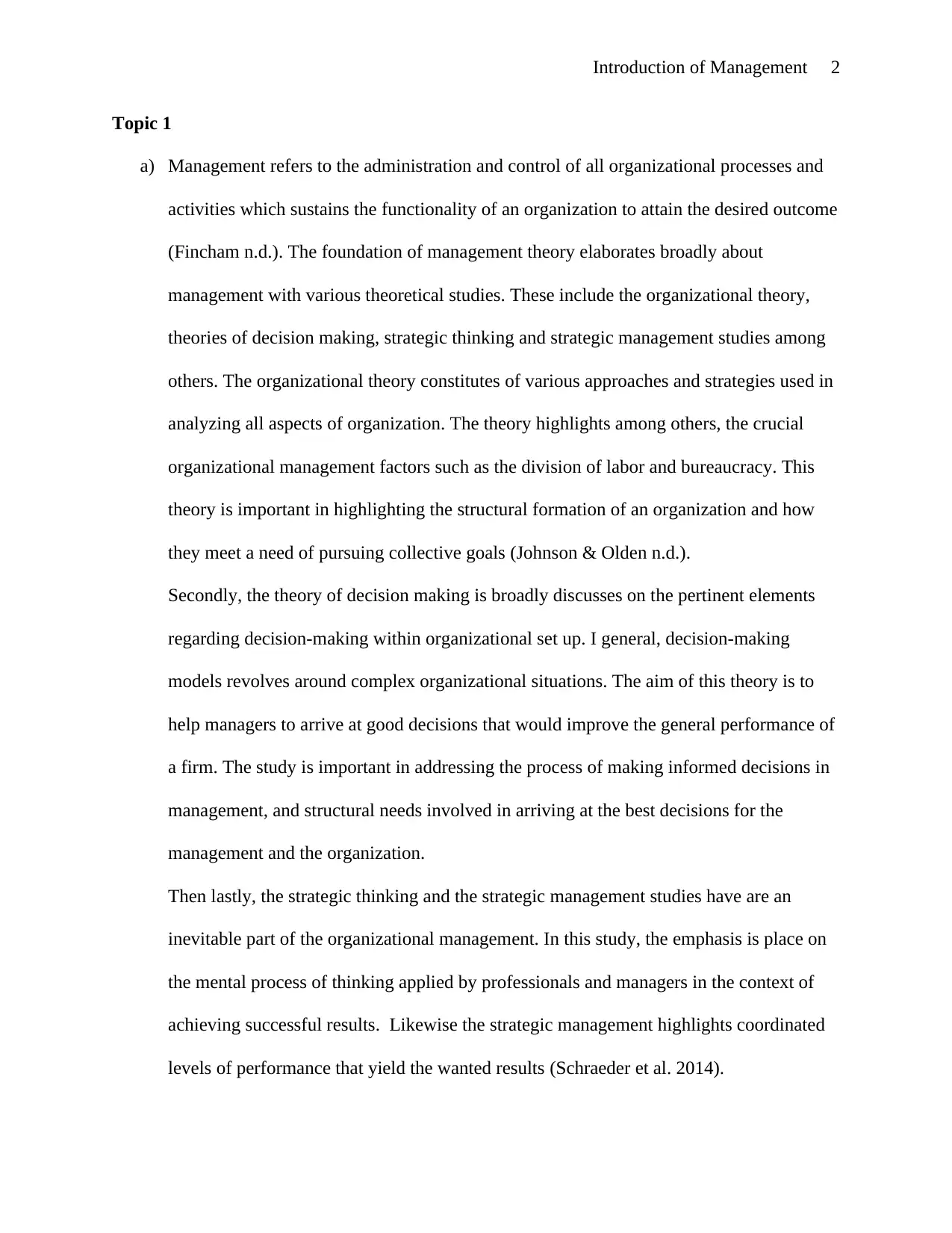
Introduction of Management 2
Topic 1
a) Management refers to the administration and control of all organizational processes and
activities which sustains the functionality of an organization to attain the desired outcome
(Fincham n.d.). The foundation of management theory elaborates broadly about
management with various theoretical studies. These include the organizational theory,
theories of decision making, strategic thinking and strategic management studies among
others. The organizational theory constitutes of various approaches and strategies used in
analyzing all aspects of organization. The theory highlights among others, the crucial
organizational management factors such as the division of labor and bureaucracy. This
theory is important in highlighting the structural formation of an organization and how
they meet a need of pursuing collective goals (Johnson & Olden n.d.).
Secondly, the theory of decision making is broadly discusses on the pertinent elements
regarding decision-making within organizational set up. I general, decision-making
models revolves around complex organizational situations. The aim of this theory is to
help managers to arrive at good decisions that would improve the general performance of
a firm. The study is important in addressing the process of making informed decisions in
management, and structural needs involved in arriving at the best decisions for the
management and the organization.
Then lastly, the strategic thinking and the strategic management studies have are an
inevitable part of the organizational management. In this study, the emphasis is place on
the mental process of thinking applied by professionals and managers in the context of
achieving successful results. Likewise the strategic management highlights coordinated
levels of performance that yield the wanted results (Schraeder et al. 2014).
Topic 1
a) Management refers to the administration and control of all organizational processes and
activities which sustains the functionality of an organization to attain the desired outcome
(Fincham n.d.). The foundation of management theory elaborates broadly about
management with various theoretical studies. These include the organizational theory,
theories of decision making, strategic thinking and strategic management studies among
others. The organizational theory constitutes of various approaches and strategies used in
analyzing all aspects of organization. The theory highlights among others, the crucial
organizational management factors such as the division of labor and bureaucracy. This
theory is important in highlighting the structural formation of an organization and how
they meet a need of pursuing collective goals (Johnson & Olden n.d.).
Secondly, the theory of decision making is broadly discusses on the pertinent elements
regarding decision-making within organizational set up. I general, decision-making
models revolves around complex organizational situations. The aim of this theory is to
help managers to arrive at good decisions that would improve the general performance of
a firm. The study is important in addressing the process of making informed decisions in
management, and structural needs involved in arriving at the best decisions for the
management and the organization.
Then lastly, the strategic thinking and the strategic management studies have are an
inevitable part of the organizational management. In this study, the emphasis is place on
the mental process of thinking applied by professionals and managers in the context of
achieving successful results. Likewise the strategic management highlights coordinated
levels of performance that yield the wanted results (Schraeder et al. 2014).
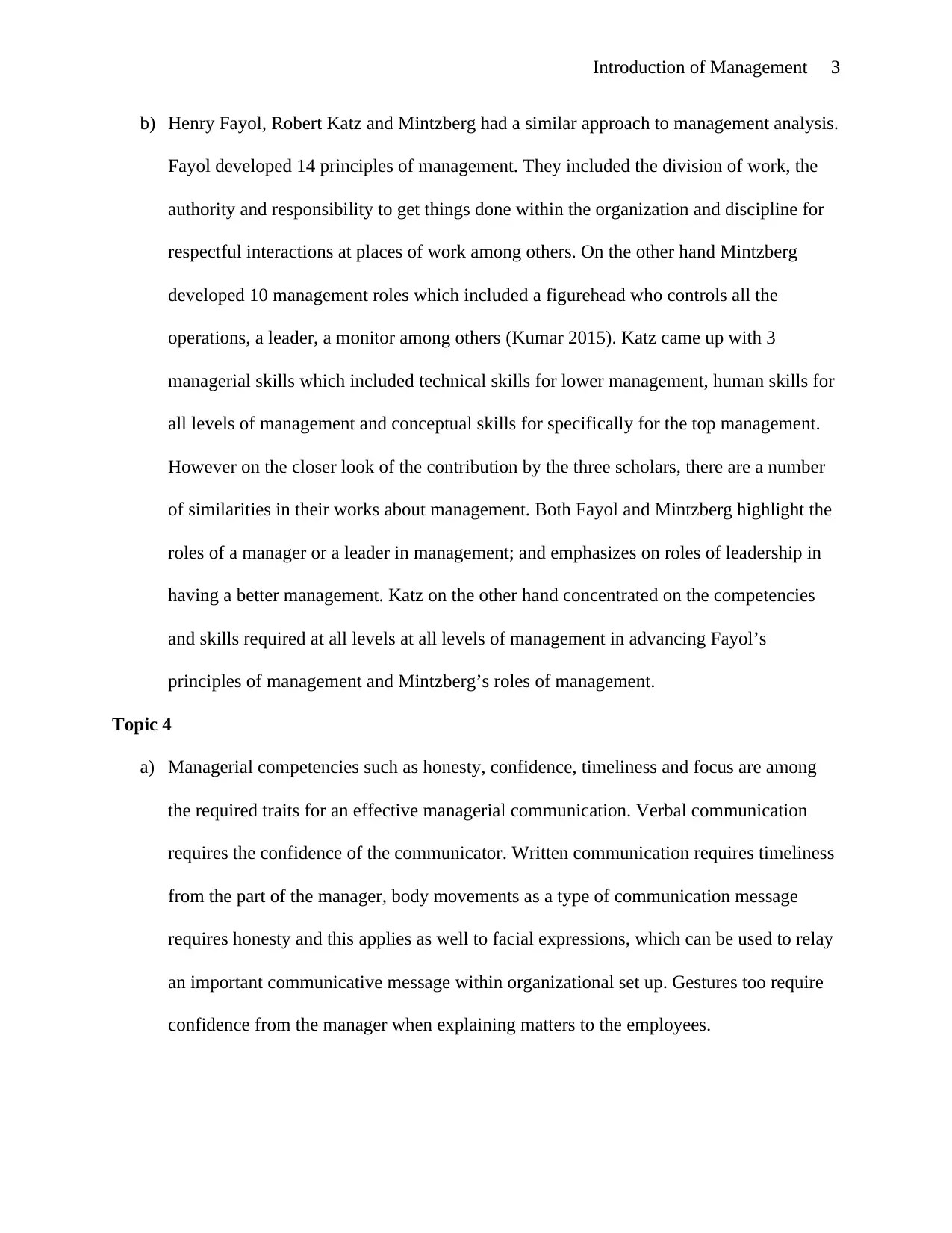
Introduction of Management 3
b) Henry Fayol, Robert Katz and Mintzberg had a similar approach to management analysis.
Fayol developed 14 principles of management. They included the division of work, the
authority and responsibility to get things done within the organization and discipline for
respectful interactions at places of work among others. On the other hand Mintzberg
developed 10 management roles which included a figurehead who controls all the
operations, a leader, a monitor among others (Kumar 2015). Katz came up with 3
managerial skills which included technical skills for lower management, human skills for
all levels of management and conceptual skills for specifically for the top management.
However on the closer look of the contribution by the three scholars, there are a number
of similarities in their works about management. Both Fayol and Mintzberg highlight the
roles of a manager or a leader in management; and emphasizes on roles of leadership in
having a better management. Katz on the other hand concentrated on the competencies
and skills required at all levels at all levels of management in advancing Fayol’s
principles of management and Mintzberg’s roles of management.
Topic 4
a) Managerial competencies such as honesty, confidence, timeliness and focus are among
the required traits for an effective managerial communication. Verbal communication
requires the confidence of the communicator. Written communication requires timeliness
from the part of the manager, body movements as a type of communication message
requires honesty and this applies as well to facial expressions, which can be used to relay
an important communicative message within organizational set up. Gestures too require
confidence from the manager when explaining matters to the employees.
b) Henry Fayol, Robert Katz and Mintzberg had a similar approach to management analysis.
Fayol developed 14 principles of management. They included the division of work, the
authority and responsibility to get things done within the organization and discipline for
respectful interactions at places of work among others. On the other hand Mintzberg
developed 10 management roles which included a figurehead who controls all the
operations, a leader, a monitor among others (Kumar 2015). Katz came up with 3
managerial skills which included technical skills for lower management, human skills for
all levels of management and conceptual skills for specifically for the top management.
However on the closer look of the contribution by the three scholars, there are a number
of similarities in their works about management. Both Fayol and Mintzberg highlight the
roles of a manager or a leader in management; and emphasizes on roles of leadership in
having a better management. Katz on the other hand concentrated on the competencies
and skills required at all levels at all levels of management in advancing Fayol’s
principles of management and Mintzberg’s roles of management.
Topic 4
a) Managerial competencies such as honesty, confidence, timeliness and focus are among
the required traits for an effective managerial communication. Verbal communication
requires the confidence of the communicator. Written communication requires timeliness
from the part of the manager, body movements as a type of communication message
requires honesty and this applies as well to facial expressions, which can be used to relay
an important communicative message within organizational set up. Gestures too require
confidence from the manager when explaining matters to the employees.
⊘ This is a preview!⊘
Do you want full access?
Subscribe today to unlock all pages.

Trusted by 1+ million students worldwide
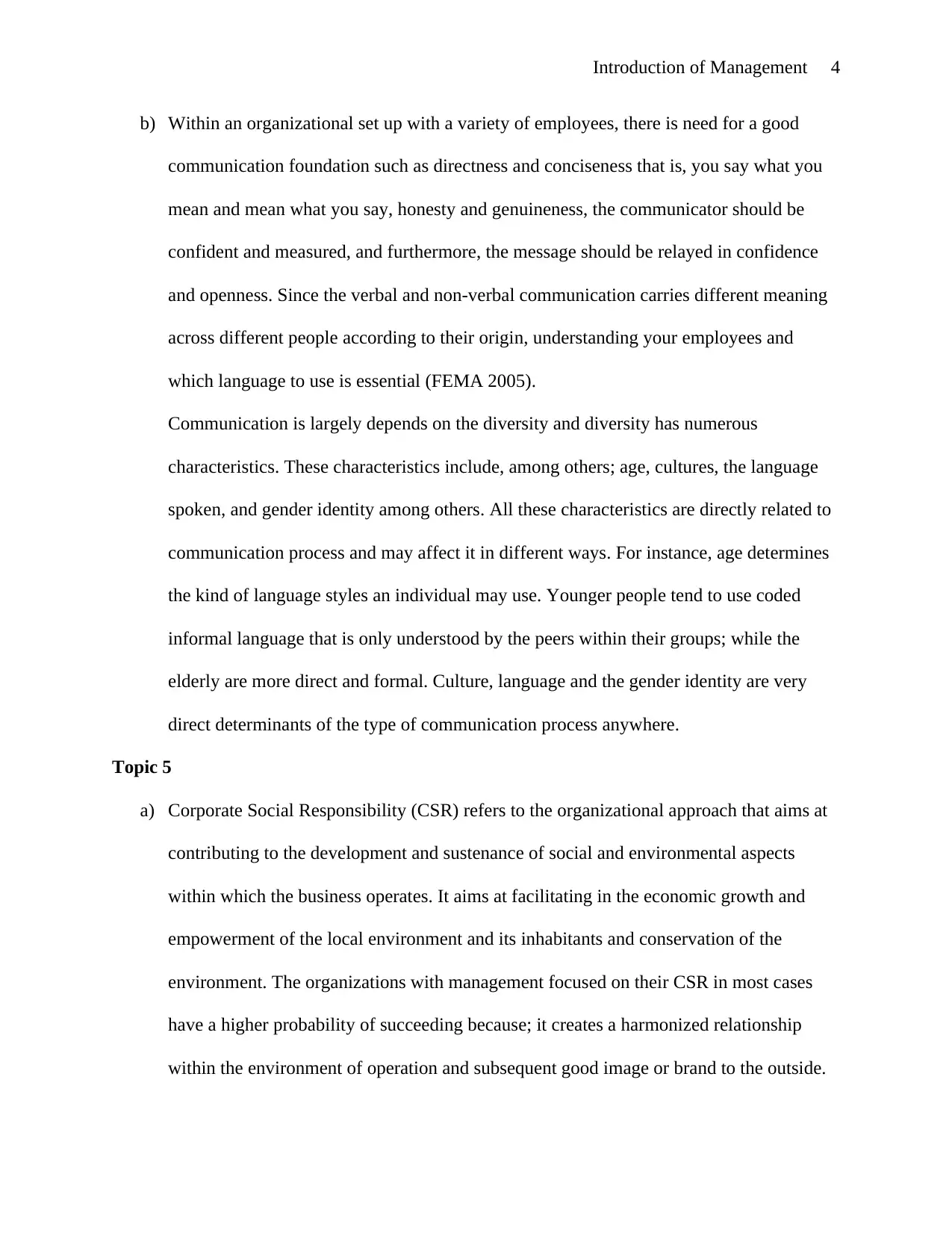
Introduction of Management 4
b) Within an organizational set up with a variety of employees, there is need for a good
communication foundation such as directness and conciseness that is, you say what you
mean and mean what you say, honesty and genuineness, the communicator should be
confident and measured, and furthermore, the message should be relayed in confidence
and openness. Since the verbal and non-verbal communication carries different meaning
across different people according to their origin, understanding your employees and
which language to use is essential (FEMA 2005).
Communication is largely depends on the diversity and diversity has numerous
characteristics. These characteristics include, among others; age, cultures, the language
spoken, and gender identity among others. All these characteristics are directly related to
communication process and may affect it in different ways. For instance, age determines
the kind of language styles an individual may use. Younger people tend to use coded
informal language that is only understood by the peers within their groups; while the
elderly are more direct and formal. Culture, language and the gender identity are very
direct determinants of the type of communication process anywhere.
Topic 5
a) Corporate Social Responsibility (CSR) refers to the organizational approach that aims at
contributing to the development and sustenance of social and environmental aspects
within which the business operates. It aims at facilitating in the economic growth and
empowerment of the local environment and its inhabitants and conservation of the
environment. The organizations with management focused on their CSR in most cases
have a higher probability of succeeding because; it creates a harmonized relationship
within the environment of operation and subsequent good image or brand to the outside.
b) Within an organizational set up with a variety of employees, there is need for a good
communication foundation such as directness and conciseness that is, you say what you
mean and mean what you say, honesty and genuineness, the communicator should be
confident and measured, and furthermore, the message should be relayed in confidence
and openness. Since the verbal and non-verbal communication carries different meaning
across different people according to their origin, understanding your employees and
which language to use is essential (FEMA 2005).
Communication is largely depends on the diversity and diversity has numerous
characteristics. These characteristics include, among others; age, cultures, the language
spoken, and gender identity among others. All these characteristics are directly related to
communication process and may affect it in different ways. For instance, age determines
the kind of language styles an individual may use. Younger people tend to use coded
informal language that is only understood by the peers within their groups; while the
elderly are more direct and formal. Culture, language and the gender identity are very
direct determinants of the type of communication process anywhere.
Topic 5
a) Corporate Social Responsibility (CSR) refers to the organizational approach that aims at
contributing to the development and sustenance of social and environmental aspects
within which the business operates. It aims at facilitating in the economic growth and
empowerment of the local environment and its inhabitants and conservation of the
environment. The organizations with management focused on their CSR in most cases
have a higher probability of succeeding because; it creates a harmonized relationship
within the environment of operation and subsequent good image or brand to the outside.
Paraphrase This Document
Need a fresh take? Get an instant paraphrase of this document with our AI Paraphraser
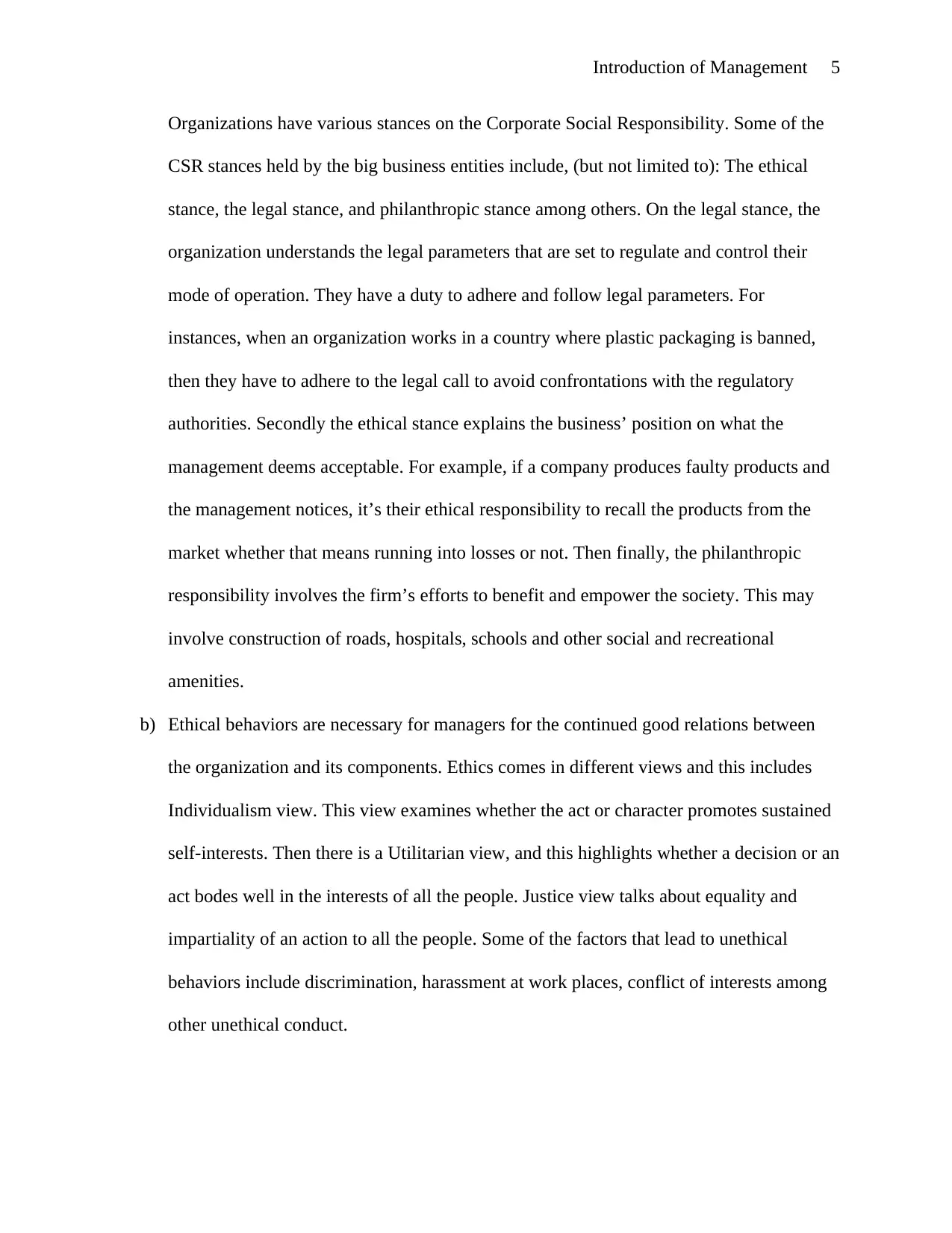
Introduction of Management 5
Organizations have various stances on the Corporate Social Responsibility. Some of the
CSR stances held by the big business entities include, (but not limited to): The ethical
stance, the legal stance, and philanthropic stance among others. On the legal stance, the
organization understands the legal parameters that are set to regulate and control their
mode of operation. They have a duty to adhere and follow legal parameters. For
instances, when an organization works in a country where plastic packaging is banned,
then they have to adhere to the legal call to avoid confrontations with the regulatory
authorities. Secondly the ethical stance explains the business’ position on what the
management deems acceptable. For example, if a company produces faulty products and
the management notices, it’s their ethical responsibility to recall the products from the
market whether that means running into losses or not. Then finally, the philanthropic
responsibility involves the firm’s efforts to benefit and empower the society. This may
involve construction of roads, hospitals, schools and other social and recreational
amenities.
b) Ethical behaviors are necessary for managers for the continued good relations between
the organization and its components. Ethics comes in different views and this includes
Individualism view. This view examines whether the act or character promotes sustained
self-interests. Then there is a Utilitarian view, and this highlights whether a decision or an
act bodes well in the interests of all the people. Justice view talks about equality and
impartiality of an action to all the people. Some of the factors that lead to unethical
behaviors include discrimination, harassment at work places, conflict of interests among
other unethical conduct.
Organizations have various stances on the Corporate Social Responsibility. Some of the
CSR stances held by the big business entities include, (but not limited to): The ethical
stance, the legal stance, and philanthropic stance among others. On the legal stance, the
organization understands the legal parameters that are set to regulate and control their
mode of operation. They have a duty to adhere and follow legal parameters. For
instances, when an organization works in a country where plastic packaging is banned,
then they have to adhere to the legal call to avoid confrontations with the regulatory
authorities. Secondly the ethical stance explains the business’ position on what the
management deems acceptable. For example, if a company produces faulty products and
the management notices, it’s their ethical responsibility to recall the products from the
market whether that means running into losses or not. Then finally, the philanthropic
responsibility involves the firm’s efforts to benefit and empower the society. This may
involve construction of roads, hospitals, schools and other social and recreational
amenities.
b) Ethical behaviors are necessary for managers for the continued good relations between
the organization and its components. Ethics comes in different views and this includes
Individualism view. This view examines whether the act or character promotes sustained
self-interests. Then there is a Utilitarian view, and this highlights whether a decision or an
act bodes well in the interests of all the people. Justice view talks about equality and
impartiality of an action to all the people. Some of the factors that lead to unethical
behaviors include discrimination, harassment at work places, conflict of interests among
other unethical conduct.
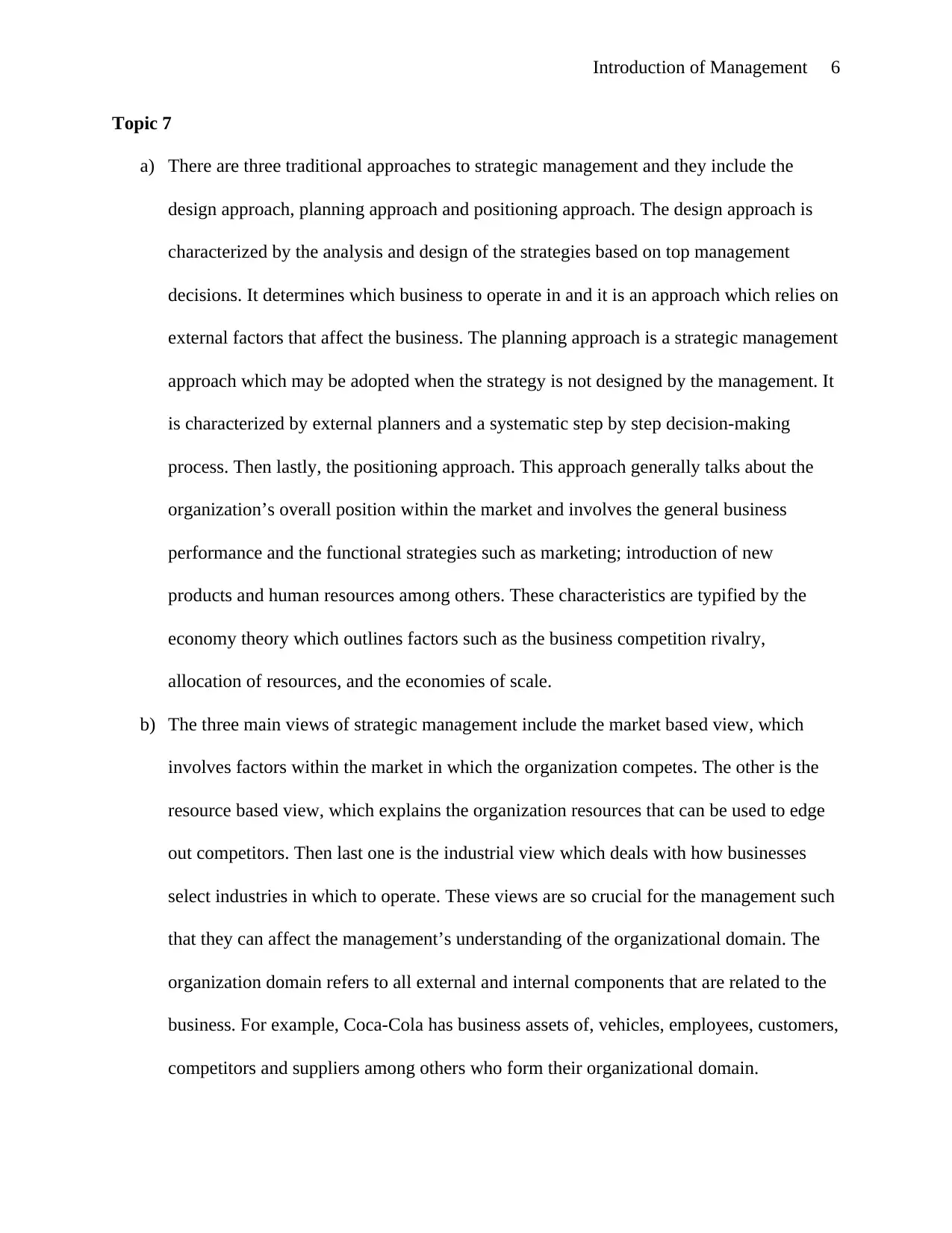
Introduction of Management 6
Topic 7
a) There are three traditional approaches to strategic management and they include the
design approach, planning approach and positioning approach. The design approach is
characterized by the analysis and design of the strategies based on top management
decisions. It determines which business to operate in and it is an approach which relies on
external factors that affect the business. The planning approach is a strategic management
approach which may be adopted when the strategy is not designed by the management. It
is characterized by external planners and a systematic step by step decision-making
process. Then lastly, the positioning approach. This approach generally talks about the
organization’s overall position within the market and involves the general business
performance and the functional strategies such as marketing; introduction of new
products and human resources among others. These characteristics are typified by the
economy theory which outlines factors such as the business competition rivalry,
allocation of resources, and the economies of scale.
b) The three main views of strategic management include the market based view, which
involves factors within the market in which the organization competes. The other is the
resource based view, which explains the organization resources that can be used to edge
out competitors. Then last one is the industrial view which deals with how businesses
select industries in which to operate. These views are so crucial for the management such
that they can affect the management’s understanding of the organizational domain. The
organization domain refers to all external and internal components that are related to the
business. For example, Coca-Cola has business assets of, vehicles, employees, customers,
competitors and suppliers among others who form their organizational domain.
Topic 7
a) There are three traditional approaches to strategic management and they include the
design approach, planning approach and positioning approach. The design approach is
characterized by the analysis and design of the strategies based on top management
decisions. It determines which business to operate in and it is an approach which relies on
external factors that affect the business. The planning approach is a strategic management
approach which may be adopted when the strategy is not designed by the management. It
is characterized by external planners and a systematic step by step decision-making
process. Then lastly, the positioning approach. This approach generally talks about the
organization’s overall position within the market and involves the general business
performance and the functional strategies such as marketing; introduction of new
products and human resources among others. These characteristics are typified by the
economy theory which outlines factors such as the business competition rivalry,
allocation of resources, and the economies of scale.
b) The three main views of strategic management include the market based view, which
involves factors within the market in which the organization competes. The other is the
resource based view, which explains the organization resources that can be used to edge
out competitors. Then last one is the industrial view which deals with how businesses
select industries in which to operate. These views are so crucial for the management such
that they can affect the management’s understanding of the organizational domain. The
organization domain refers to all external and internal components that are related to the
business. For example, Coca-Cola has business assets of, vehicles, employees, customers,
competitors and suppliers among others who form their organizational domain.
⊘ This is a preview!⊘
Do you want full access?
Subscribe today to unlock all pages.

Trusted by 1+ million students worldwide
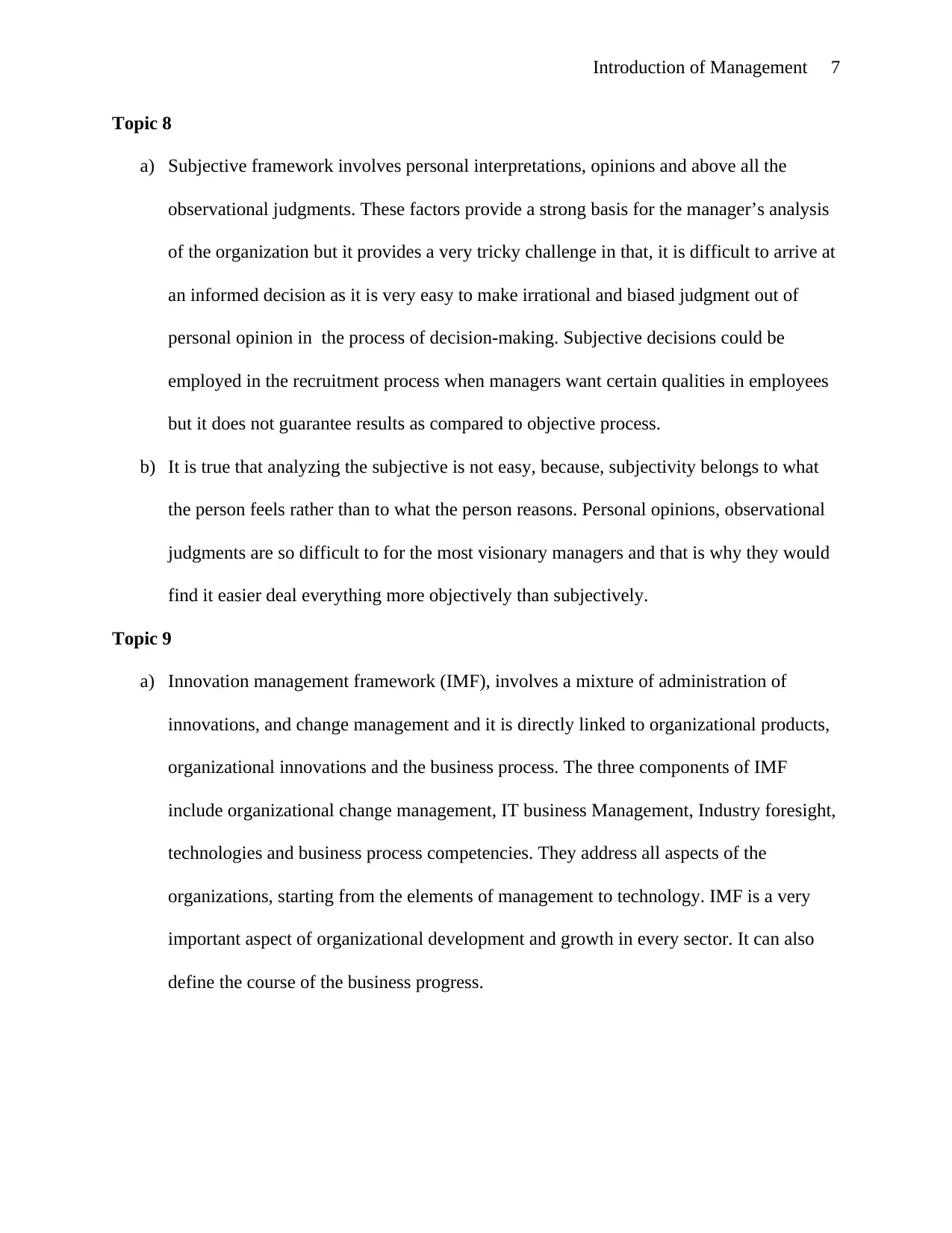
Introduction of Management 7
Topic 8
a) Subjective framework involves personal interpretations, opinions and above all the
observational judgments. These factors provide a strong basis for the manager’s analysis
of the organization but it provides a very tricky challenge in that, it is difficult to arrive at
an informed decision as it is very easy to make irrational and biased judgment out of
personal opinion in the process of decision-making. Subjective decisions could be
employed in the recruitment process when managers want certain qualities in employees
but it does not guarantee results as compared to objective process.
b) It is true that analyzing the subjective is not easy, because, subjectivity belongs to what
the person feels rather than to what the person reasons. Personal opinions, observational
judgments are so difficult to for the most visionary managers and that is why they would
find it easier deal everything more objectively than subjectively.
Topic 9
a) Innovation management framework (IMF), involves a mixture of administration of
innovations, and change management and it is directly linked to organizational products,
organizational innovations and the business process. The three components of IMF
include organizational change management, IT business Management, Industry foresight,
technologies and business process competencies. They address all aspects of the
organizations, starting from the elements of management to technology. IMF is a very
important aspect of organizational development and growth in every sector. It can also
define the course of the business progress.
Topic 8
a) Subjective framework involves personal interpretations, opinions and above all the
observational judgments. These factors provide a strong basis for the manager’s analysis
of the organization but it provides a very tricky challenge in that, it is difficult to arrive at
an informed decision as it is very easy to make irrational and biased judgment out of
personal opinion in the process of decision-making. Subjective decisions could be
employed in the recruitment process when managers want certain qualities in employees
but it does not guarantee results as compared to objective process.
b) It is true that analyzing the subjective is not easy, because, subjectivity belongs to what
the person feels rather than to what the person reasons. Personal opinions, observational
judgments are so difficult to for the most visionary managers and that is why they would
find it easier deal everything more objectively than subjectively.
Topic 9
a) Innovation management framework (IMF), involves a mixture of administration of
innovations, and change management and it is directly linked to organizational products,
organizational innovations and the business process. The three components of IMF
include organizational change management, IT business Management, Industry foresight,
technologies and business process competencies. They address all aspects of the
organizations, starting from the elements of management to technology. IMF is a very
important aspect of organizational development and growth in every sector. It can also
define the course of the business progress.
Paraphrase This Document
Need a fresh take? Get an instant paraphrase of this document with our AI Paraphraser
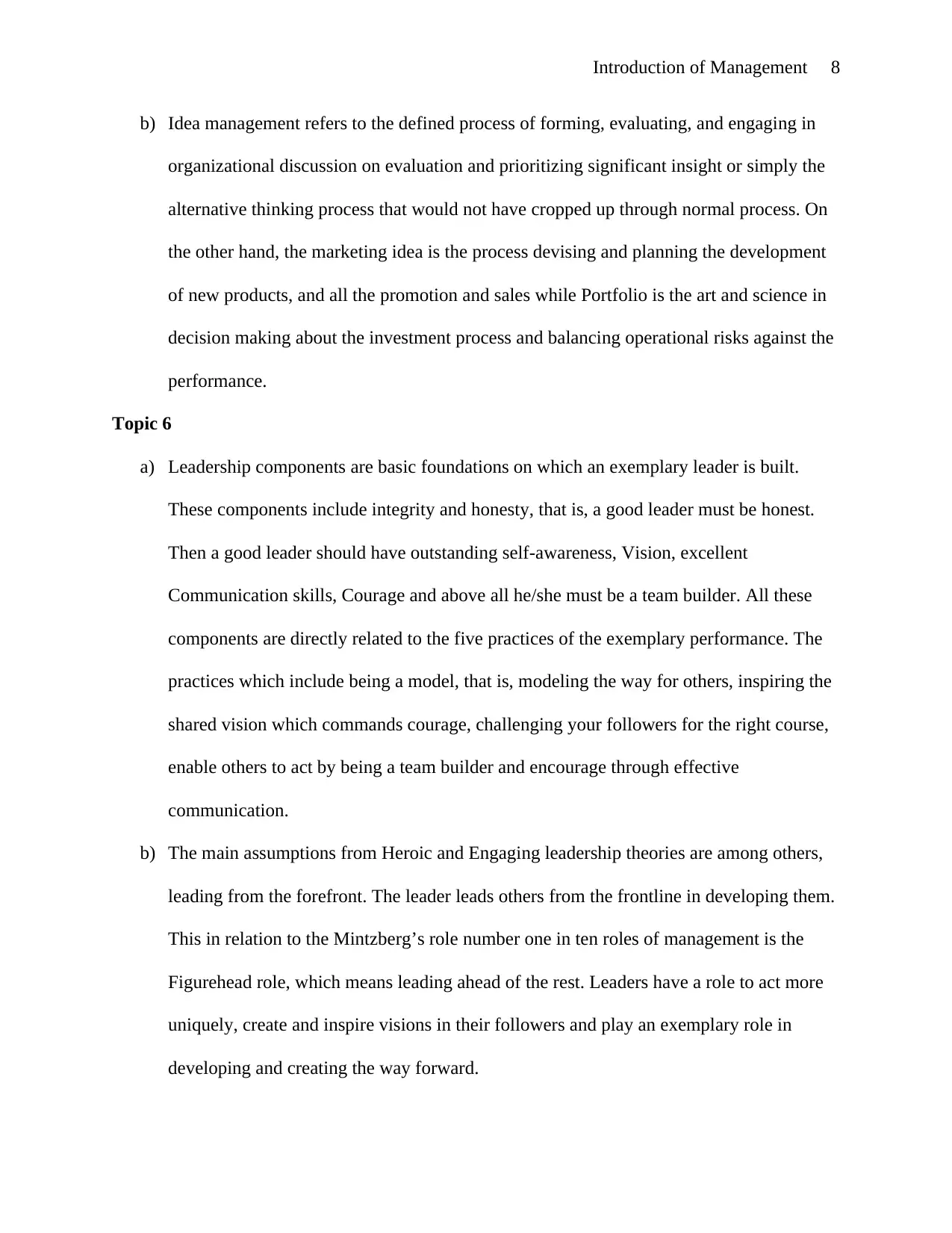
Introduction of Management 8
b) Idea management refers to the defined process of forming, evaluating, and engaging in
organizational discussion on evaluation and prioritizing significant insight or simply the
alternative thinking process that would not have cropped up through normal process. On
the other hand, the marketing idea is the process devising and planning the development
of new products, and all the promotion and sales while Portfolio is the art and science in
decision making about the investment process and balancing operational risks against the
performance.
Topic 6
a) Leadership components are basic foundations on which an exemplary leader is built.
These components include integrity and honesty, that is, a good leader must be honest.
Then a good leader should have outstanding self-awareness, Vision, excellent
Communication skills, Courage and above all he/she must be a team builder. All these
components are directly related to the five practices of the exemplary performance. The
practices which include being a model, that is, modeling the way for others, inspiring the
shared vision which commands courage, challenging your followers for the right course,
enable others to act by being a team builder and encourage through effective
communication.
b) The main assumptions from Heroic and Engaging leadership theories are among others,
leading from the forefront. The leader leads others from the frontline in developing them.
This in relation to the Mintzberg’s role number one in ten roles of management is the
Figurehead role, which means leading ahead of the rest. Leaders have a role to act more
uniquely, create and inspire visions in their followers and play an exemplary role in
developing and creating the way forward.
b) Idea management refers to the defined process of forming, evaluating, and engaging in
organizational discussion on evaluation and prioritizing significant insight or simply the
alternative thinking process that would not have cropped up through normal process. On
the other hand, the marketing idea is the process devising and planning the development
of new products, and all the promotion and sales while Portfolio is the art and science in
decision making about the investment process and balancing operational risks against the
performance.
Topic 6
a) Leadership components are basic foundations on which an exemplary leader is built.
These components include integrity and honesty, that is, a good leader must be honest.
Then a good leader should have outstanding self-awareness, Vision, excellent
Communication skills, Courage and above all he/she must be a team builder. All these
components are directly related to the five practices of the exemplary performance. The
practices which include being a model, that is, modeling the way for others, inspiring the
shared vision which commands courage, challenging your followers for the right course,
enable others to act by being a team builder and encourage through effective
communication.
b) The main assumptions from Heroic and Engaging leadership theories are among others,
leading from the forefront. The leader leads others from the frontline in developing them.
This in relation to the Mintzberg’s role number one in ten roles of management is the
Figurehead role, which means leading ahead of the rest. Leaders have a role to act more
uniquely, create and inspire visions in their followers and play an exemplary role in
developing and creating the way forward.
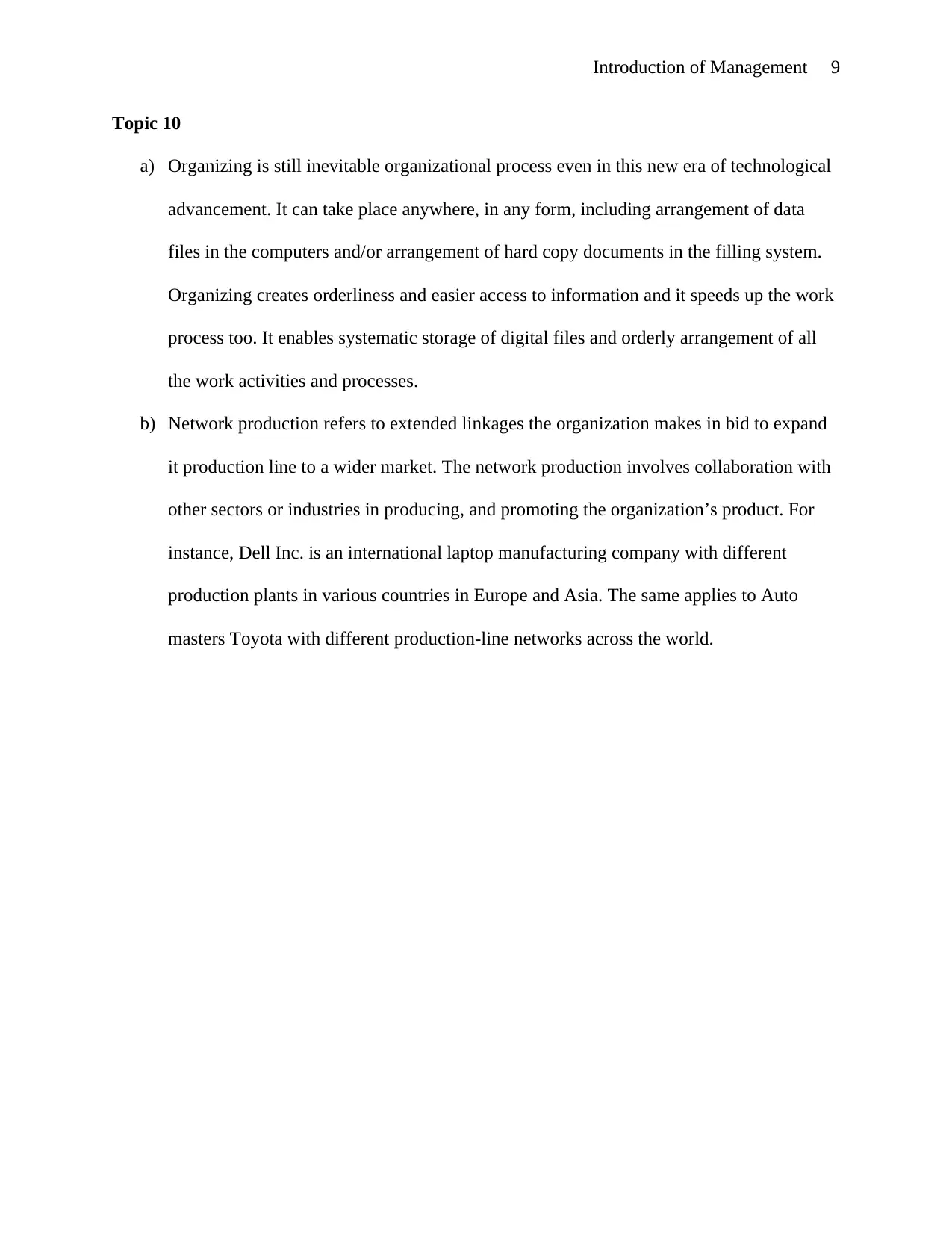
Introduction of Management 9
Topic 10
a) Organizing is still inevitable organizational process even in this new era of technological
advancement. It can take place anywhere, in any form, including arrangement of data
files in the computers and/or arrangement of hard copy documents in the filling system.
Organizing creates orderliness and easier access to information and it speeds up the work
process too. It enables systematic storage of digital files and orderly arrangement of all
the work activities and processes.
b) Network production refers to extended linkages the organization makes in bid to expand
it production line to a wider market. The network production involves collaboration with
other sectors or industries in producing, and promoting the organization’s product. For
instance, Dell Inc. is an international laptop manufacturing company with different
production plants in various countries in Europe and Asia. The same applies to Auto
masters Toyota with different production-line networks across the world.
Topic 10
a) Organizing is still inevitable organizational process even in this new era of technological
advancement. It can take place anywhere, in any form, including arrangement of data
files in the computers and/or arrangement of hard copy documents in the filling system.
Organizing creates orderliness and easier access to information and it speeds up the work
process too. It enables systematic storage of digital files and orderly arrangement of all
the work activities and processes.
b) Network production refers to extended linkages the organization makes in bid to expand
it production line to a wider market. The network production involves collaboration with
other sectors or industries in producing, and promoting the organization’s product. For
instance, Dell Inc. is an international laptop manufacturing company with different
production plants in various countries in Europe and Asia. The same applies to Auto
masters Toyota with different production-line networks across the world.
⊘ This is a preview!⊘
Do you want full access?
Subscribe today to unlock all pages.

Trusted by 1+ million students worldwide
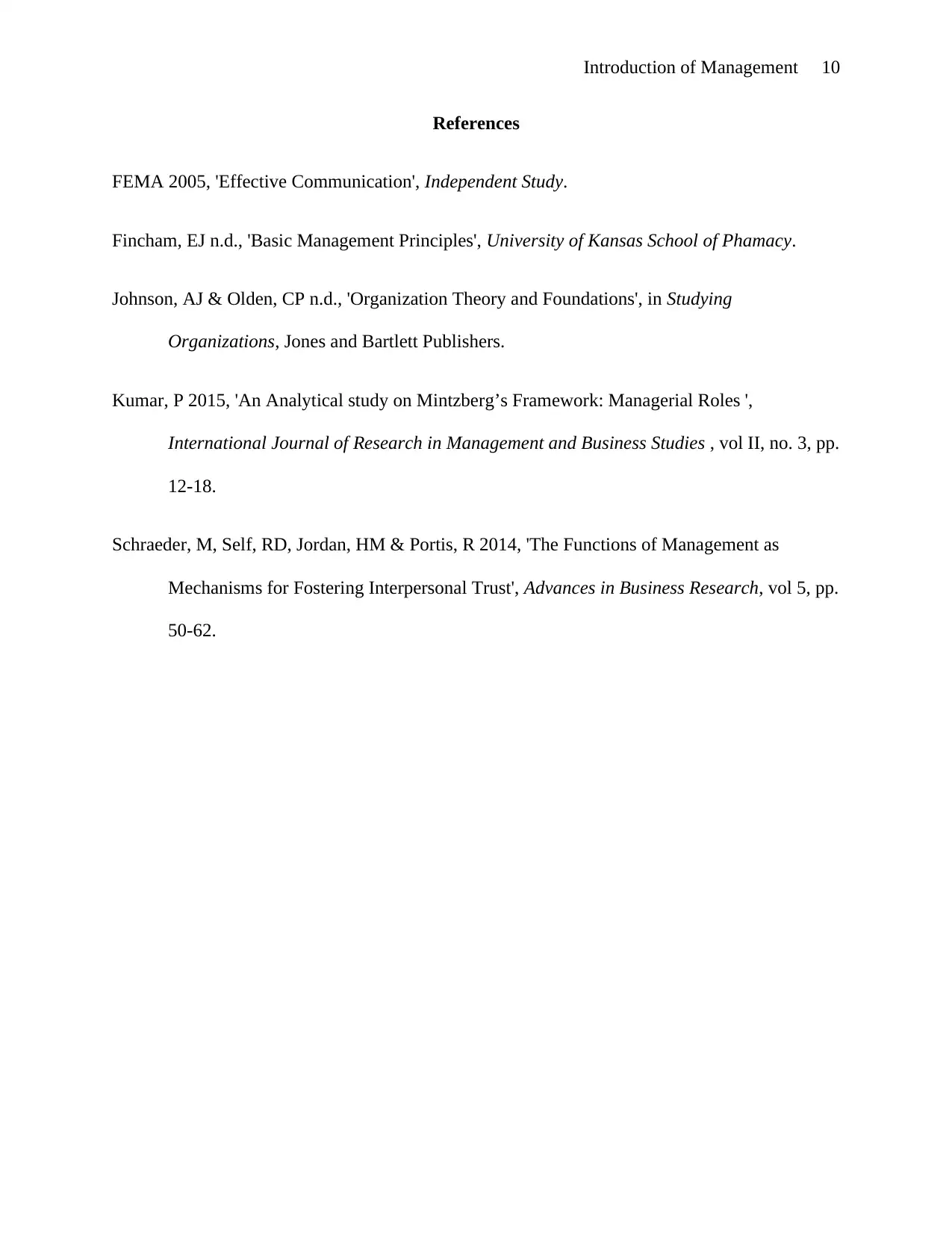
Introduction of Management 10
References
FEMA 2005, 'Effective Communication', Independent Study.
Fincham, EJ n.d., 'Basic Management Principles', University of Kansas School of Phamacy.
Johnson, AJ & Olden, CP n.d., 'Organization Theory and Foundations', in Studying
Organizations, Jones and Bartlett Publishers.
Kumar, P 2015, 'An Analytical study on Mintzberg’s Framework: Managerial Roles ',
International Journal of Research in Management and Business Studies , vol II, no. 3, pp.
12-18.
Schraeder, M, Self, RD, Jordan, HM & Portis, R 2014, 'The Functions of Management as
Mechanisms for Fostering Interpersonal Trust', Advances in Business Research, vol 5, pp.
50-62.
References
FEMA 2005, 'Effective Communication', Independent Study.
Fincham, EJ n.d., 'Basic Management Principles', University of Kansas School of Phamacy.
Johnson, AJ & Olden, CP n.d., 'Organization Theory and Foundations', in Studying
Organizations, Jones and Bartlett Publishers.
Kumar, P 2015, 'An Analytical study on Mintzberg’s Framework: Managerial Roles ',
International Journal of Research in Management and Business Studies , vol II, no. 3, pp.
12-18.
Schraeder, M, Self, RD, Jordan, HM & Portis, R 2014, 'The Functions of Management as
Mechanisms for Fostering Interpersonal Trust', Advances in Business Research, vol 5, pp.
50-62.
1 out of 10
Related Documents
Your All-in-One AI-Powered Toolkit for Academic Success.
+13062052269
info@desklib.com
Available 24*7 on WhatsApp / Email
![[object Object]](/_next/static/media/star-bottom.7253800d.svg)
Unlock your academic potential
Copyright © 2020–2025 A2Z Services. All Rights Reserved. Developed and managed by ZUCOL.





